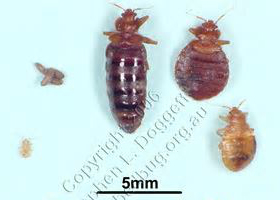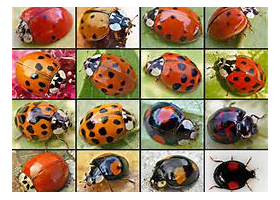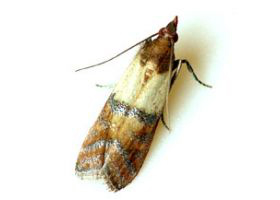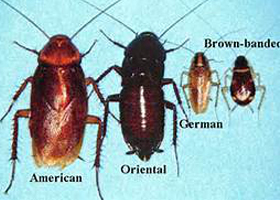|
|
Types Of Bugs
Ants
 Ant Control: First identify the type of ant, then pick the correct product to remove the infestation Ant baits and non-repellent insecticide sprays are two popular methods for household ant control. Ant Control: First identify the type of ant, then pick the correct product to remove the infestation Ant baits and non-repellent insecticide sprays are two popular methods for household ant control.
Using both protein and sweet baits is the most effective method to bait ants. |
Bed Bug
 The life cycle stages of a bed bug are egg, nymph, and adult. Eggs are laid along the edges of or around buttons on the mattresses. Eggs can also be glued to rough surfaces. The life cycle stages of a bed bug are egg, nymph, and adult. Eggs are laid along the edges of or around buttons on the mattresses. Eggs can also be glued to rough surfaces.
Bed bug females lay about 200 eggs, usually at the rate of three or four a day, in cracks and crevices in the floor or bed. Eggs are placed in cracks, crevices and other isolated and protected shelters. Females lay eggs after a blood meal. Eggs will hatch in one or two weeks into Nymphs. Newly hatched bugs(Nymphs) begin feeding immediately.
|
Carpenter Bees
 Carpenter Bee prevention and extermination is usually best done before nesting activity gets started. If you do not have a chance to paint or varnish the unfinished wood, before they begin to bore into the wood, spray the unfinished wood in these vulnerable areas (under rail sidings, under decks, around window sills, etc) with a good residual spray. The best time to spray preventively for carpenter bee control is spring time. Nesting and the rearing of young carpenter bees occur in the late spring or early summer . These residual insecticides will last 2-3 months, then retreat until the fall season. Carpenter Bee prevention and extermination is usually best done before nesting activity gets started. If you do not have a chance to paint or varnish the unfinished wood, before they begin to bore into the wood, spray the unfinished wood in these vulnerable areas (under rail sidings, under decks, around window sills, etc) with a good residual spray. The best time to spray preventively for carpenter bee control is spring time. Nesting and the rearing of young carpenter bees occur in the late spring or early summer . These residual insecticides will last 2-3 months, then retreat until the fall season. |
Flea
 The average flea ranges in size from 1/12 to 1/6 inch long. Fleas are very small and have no wings. Fleas are parasites, feeding directly on humans or other warm blooded animals. Usually you or your pet serve as these hosts. The average flea ranges in size from 1/12 to 1/6 inch long. Fleas are very small and have no wings. Fleas are parasites, feeding directly on humans or other warm blooded animals. Usually you or your pet serve as these hosts.
A flea can jump 7 to 8 inches vertically and 14 to 16 inches horizontally. A skin reaction to a flea bite appears as a slightly raised and red itchy spot. Sometimes these sores bleed. Fleas usually require warm and humid conditions to develop. Due to the flea cycle and weather conditions, many people don't realize they have a flea problem until they return home from vacation or after a move to new premises and are confronted by hungry fleas. |
Flies
 they transmit diseases, as well. Flies, like the common house fly, breed in rotten food, manure and garbage and is classified as a filth fly. It doesn't take long for a fly to mature, as short as ten days; many generations can occur extremely quickly. Fly control is a continuous task for this reason. An effective fly control program begins with sanitation and exclusion management. After sanitation and exclusion, we carry a wide assortment of insecticides that come in residual forms, aerosols, fogging materials, and baiting forms. Fly Lights with distinctive UV spectrums attract flies and traps them. they transmit diseases, as well. Flies, like the common house fly, breed in rotten food, manure and garbage and is classified as a filth fly. It doesn't take long for a fly to mature, as short as ten days; many generations can occur extremely quickly. Fly control is a continuous task for this reason. An effective fly control program begins with sanitation and exclusion management. After sanitation and exclusion, we carry a wide assortment of insecticides that come in residual forms, aerosols, fogging materials, and baiting forms. Fly Lights with distinctive UV spectrums attract flies and traps them.
|
Lady Bug
 Once ladybugs have become established in the home, there aren't a lot of chemical treatment options. The easiest way to remove ladybugs, once they are indoors, is with a vacuum cleaner. To help prevent asian lady beetles, cluster flies, box elder bugs and similar pests from entering in the fall, spray outdoors using a fast-acting synthetic pyrethroids. Once ladybugs have become established in the home, there aren't a lot of chemical treatment options. The easiest way to remove ladybugs, once they are indoors, is with a vacuum cleaner. To help prevent asian lady beetles, cluster flies, box elder bugs and similar pests from entering in the fall, spray outdoors using a fast-acting synthetic pyrethroids.
This is done during the Fall time. Generally spray the south and south west exposure of the house. Spray from the ground up as high as you can go. |
Moths
 Prevention is the best option by laundering before long storage times. However if you have these fabric pests, first inspect the infestations. You should make a thorough inspection of infested premises to find all sources of infestation. After inspection, you can use a variety of treatments. Pantry pests and pantry moths are truly "pests". These stored product pests are called pantry pests as a whole group collectively. They have an appetite for stored food products (people and pet foods) such as, flour, cereal, dry pasta, dry pet food, powdered milk, corn starch, crackers, spices, breads, bird seed, dried nuts and fruit. Prevention is the best option by laundering before long storage times. However if you have these fabric pests, first inspect the infestations. You should make a thorough inspection of infested premises to find all sources of infestation. After inspection, you can use a variety of treatments. Pantry pests and pantry moths are truly "pests". These stored product pests are called pantry pests as a whole group collectively. They have an appetite for stored food products (people and pet foods) such as, flour, cereal, dry pasta, dry pet food, powdered milk, corn starch, crackers, spices, breads, bird seed, dried nuts and fruit.
|
Roaches Adult German roaches range in size from 1/2 inch- 5/8 inch long. They are light to medium brown. They have 2 dark distinctive stripes behind the head. The young German roaches (nymphs) are smaller than adults and are wingless. They have a light stripe on their backs and are darker in color. Females produce one egg capsule every 3-4 weeks. Each capsule contains 25-45 eggs. Adult German roaches range in size from 1/2 inch- 5/8 inch long. They are light to medium brown. They have 2 dark distinctive stripes behind the head. The young German roaches (nymphs) are smaller than adults and are wingless. They have a light stripe on their backs and are darker in color. Females produce one egg capsule every 3-4 weeks. Each capsule contains 25-45 eggs.
American Cockroaches prefer decaying organic matter, but being scavengers will eat anything. Sweets are attractive to the American roach. Females produce many egg capsules, having 14-16 eggs hatching in 50-55 days into grayish-brown "nymphs". Female American Roaches prefer to deposit their eggs in protected and damp areas. Nymphs will molt 9 to 13 times before reaching maturity. |
Termites
 Termites are small, ant-like insects. However, they differ from ants in that they feed off the cellulose in wood. Working largely unseen under the surface, they can tunnel through the wooden structural members in buildings and completely destroy them. Wood that comes in contact with the soil, such as the exterior trim or cladding on your home, provides a perfect point of entry for a termite colony. Inged adults are often called swarmers, they are primary reproductives. They emerge from the colonies on colonizing flights during certain seasons in the year. After the flights, the male(king) and female(queen) will pair up, lose their wings and construct a small cell in the soil. Termites are small, ant-like insects. However, they differ from ants in that they feed off the cellulose in wood. Working largely unseen under the surface, they can tunnel through the wooden structural members in buildings and completely destroy them. Wood that comes in contact with the soil, such as the exterior trim or cladding on your home, provides a perfect point of entry for a termite colony. Inged adults are often called swarmers, they are primary reproductives. They emerge from the colonies on colonizing flights during certain seasons in the year. After the flights, the male(king) and female(queen) will pair up, lose their wings and construct a small cell in the soil.
|
|
|

